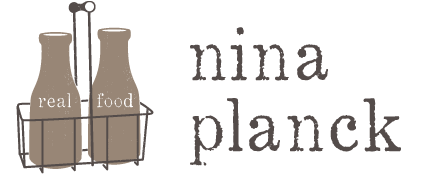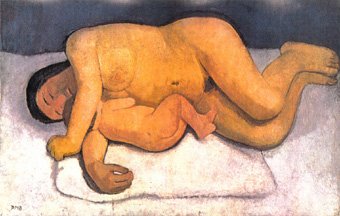Real Food for Nursing Mothers
12/18/06
by Paula Moderson Becker
Since Julian arrived in October, we go across the street to La Leche League meetings, where I meet other mothers who nurse their babies for the simple reason that it's the best food for babies. We get practical advice about nursing, swap stories, and make friends.
Naturally, these mothers are well informed about nutrition - that's why they breastfeed. But I'm concerned about what passes for good nutrition in this all-important period. I believe the advice many well-informed, health-conscious women have absorbed is out of date and risky.
Low-fat, vegan, and vegetarian diets are not ideal for pregnant women, nursing, mothers, or babies, in my view. They are likely to be deficient in three important nutrients: omega-3 fats (found only in fish oil, and in less-available plant sources such as flax seed oil); quality protein (rice and beans are not quality protein); and vitamins B12, A, and D - found only fully formed in animal products such as meat and dairy.
The breast-fed baby gets all his nutrients from his mother. He needs quality fat (especially fish oil and lauric acid, found in breast milk and coconut oil) and lots of protein. After a long pregnancy, the nursing mother is likely to be depleted of fish oil - during pregnancy and nursing the baby steal all the omega-3 fats she can from her mother's reserves. Vegan and vegetarian mothers are more likely to be deficient in omega-3 fats. This is a major cause of post-natal depression. Omega-3 deficiency is cumulative and progressive, by the way. That means with each pregnancy the woman loses her stores, unless she eats plenty of fish.
I meet vegan and vegetarian mothers with poor milk supply, allergies, and eczema. I suspect nutritional causes of these problems, though it's impossible to diagnose any individual case. Their babies sometimes grab for solid food at three or four months. It's possible, I think, that vegan and vegetarian breast milk is not sufficiently nutritious, and that's why babies seek solid food early. All babies are different, of course, but many won't want any food until nine months or so. The breastmilk of a well-fed woman is enough for a long time.
It's worth noting the one nutrient breast milk is short of: iron. That's because iron binds with lactoferrin, which kills E coli, a major risk to all newborn mammals. Most mammals' milk contains no iron to increase the lactoferrin and reduce the risk of E coli infection in the vulnerable newborn.  Not to worry: a well nourished baby needs no supplementary or extra iron until a year or so, and then real food will be fine. The lack of iron in breast milk does explain why lightly cooked and even raw liver (rich in iron) is a first food for babies in Africa.
One food I would absolutely avoid if nursing: soy 'milk' and other industrial soy products. It's too rich in estrogen for babies and causes thyroid problems. Thyroid problems cause stunted growth. That's why soy formula is particularly bad for babies.
For first foods, the standard American baby food - cereals - may not be wise. Babies lack sufficient amylase, the enzyme required to digest starch. That's one reason bananas are a good first food; they contain plenty of their own amylase.
Instead, consider lightly cooked egg yolks, yogurt, coconut oil, and protein as first foods. Of course, cooked and pureed vegetables, such as sweet potatoes, are good too. I hope to have more ideas soon, because I'm at work on a new book, Baby Food, in which I'll talk about The Fertility Diet, Eating for Two, and First Foods. It's my feeling that from zero to two (including pregnancy) the overwhelming nutritional requirements are for quality fat and protein - not lettuce and not low-fat anything. You are building a whole new person, muscle, bone, brain and all.
Til Baby Food comes out, then, the Weston Price Foundation has good advice about real food for pregnant and nursing mothers. As you'll see below, breastmilk is not made of vegetables (though I do eat plenty of those).
Cod Liver Oil to supply 20,000 IU vitamin A and 2000 IU vitamin D per day
1 quart (or 32 ounces) whole milk daily, preferably raw and from pasture-fed cows (learn more about raw milk at www.realmilk.com)
4 tablespoons butter daily, preferably from pasture-fed cows
2 or more eggs daily, preferably from pastured chickens
3-4 ounces fresh liver, once or twice per week (If you have been told to avoid liver for fear of getting "too much Vitamin A," be sure to read Vitamin A Saga)
Seafood, 2-4 times per week, particularly wild salmon, shellfish and fish eggs
Fresh beef or lamb daily, always consumed with the fat
Oily fish or lard daily, for vitamin D
2 tablespoons coconut oil daily, used in cooking or smoothies, etc.
Bone broths used in soups, stews and sauces
Soaked whole grains
Fresh vegetables and fruits

